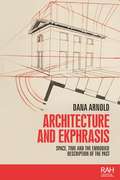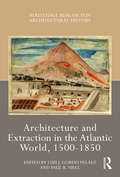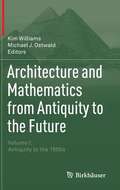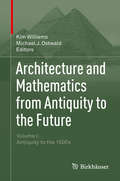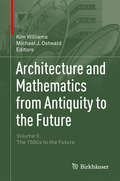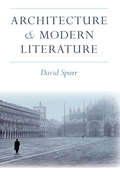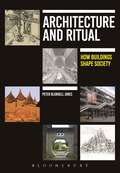- Table View
- List View
Architecture and Collective Life
by Penny LewisThis book addresses the complex relationship between architecture and public life. It’s a study of architecture and urbanism as cultural activity that both reflects and gives shape to our social relations, public institutions and political processes. Written by an international range of contributors, the chapters address the intersection of public life and the built environment around the themes of authority and planning, the welfare state, place and identity and autonomy. The book covers a diverse range of material from Foucault’s evolving thoughts on space to land-scraping leisure centres in inter-war Belgium. It unpacks concepts such as ‘community’ and ‘collectivity’ alongside themes of self-organisation and authorship. Architecture and Collective Life reflects on urban and architectural practice and historical, political and social change. As such this book will be of great interest to students and academics in architecture and urbanism as well as practicing architects.
Architecture and Collective Life
by Penny Lewis Lorens Holm Sandra Costa SantosThis book addresses the complex relationship between architecture and public life. It’s a study of architecture and urbanism as cultural activity that both reflects and gives shape to our social relations, public institutions and political processes. Written by an international range of contributors, the chapters address the intersection of public life and the built environment around the themes of authority and planning, the welfare state, place and identity and autonomy. The book covers a diverse range of material from Foucault’s evolving thoughts on space to land-scraping leisure centres in inter-war Belgium. It unpacks concepts such as ‘community’ and ‘collectivity’ alongside themes of self-organisation and authorship. Architecture and Collective Life reflects on urban and architectural practice and historical, political and social change. As such this book will be of great interest to students and academics in architecture and urbanism as well as practicing architects.
Architecture and ekphrasis: Space, time and the embodied description of the past (Rethinking Art's Histories)
by Dana ArnoldArchitecture and ekphrasis examines how eighteenth-century prints and drawings of antique architecture operated as representations of thought. Using original archival material, it considers the idea of the past in the period, specifically how it was discovered and described, and investigates how space and time inform visual ekphrasis or descriptions of architecture. The idea of embodiment is used to explore the various methods of describing architecture – including graphic techniques, measurement and perspective – all of which demonstrate choices about different modes of ekphrasis. This well-illustrated, accessibly written study will be of interest to academics and students working in a broad range of subject areas. It will also be an essential teaching tool for increasingly popular cross-disciplinary courses.
Architecture and ekphrasis: Space, time and the embodied description of the past (Rethinking Art's Histories)
by Dana ArnoldArchitecture and ekphrasis examines how eighteenth-century prints and drawings of antique architecture operated as representations of thought. Using original archival material, it considers the idea of the past in the period, specifically how it was discovered and described, and investigates how space and time inform visual ekphrasis or descriptions of architecture. The idea of embodiment is used to explore the various methods of describing architecture – including graphic techniques, measurement and perspective – all of which demonstrate choices about different modes of ekphrasis. This well-illustrated, accessibly written study will be of interest to academics and students working in a broad range of subject areas. It will also be an essential teaching tool for increasingly popular cross-disciplinary courses.
Architecture and Embodiment: The Implications of the New Sciences and Humanities for Design
by Harry Francis MallgraveIn recent years we have seen a number of dramatic discoveries within the biological and related sciences. Traditional arguments such as "nature versus nurture" are rapidly disappearing because of the realization that just as we are affecting our environments, so too do these altered environments restructure our cognitive abilities and outlooks. If the biological and technological breakthroughs are promising benefits such as extended life expectancies, these same discoveries also have the potential to improve in significant ways the quality of our built environments. This poses a compelling challenge to conventional architectural theory... This is the first book to consider these new scientific and humanistic models in architectural terms. Constructed as a series of five essays around the themes of beauty, culture, emotion, the experience of architecture, and artistic play, this book draws upon a broad range of discussions taking place in philosophy, psychology, biology, neuroscience, and anthropology, and in doing so questions what implications these discussions hold for architectural design. Drawing upon a wealth of research, Mallgrave argues that we should turn our focus away from the objectification of architecture (treating design as the creation of objects) and redirect it back to those for whom we design: the people inhabiting our built environments.
Architecture and Embodiment: The Implications of the New Sciences and Humanities for Design
by Harry Francis MallgraveIn recent years we have seen a number of dramatic discoveries within the biological and related sciences. Traditional arguments such as "nature versus nurture" are rapidly disappearing because of the realization that just as we are affecting our environments, so too do these altered environments restructure our cognitive abilities and outlooks. If the biological and technological breakthroughs are promising benefits such as extended life expectancies, these same discoveries also have the potential to improve in significant ways the quality of our built environments. This poses a compelling challenge to conventional architectural theory... This is the first book to consider these new scientific and humanistic models in architectural terms. Constructed as a series of five essays around the themes of beauty, culture, emotion, the experience of architecture, and artistic play, this book draws upon a broad range of discussions taking place in philosophy, psychology, biology, neuroscience, and anthropology, and in doing so questions what implications these discussions hold for architectural design. Drawing upon a wealth of research, Mallgrave argues that we should turn our focus away from the objectification of architecture (treating design as the creation of objects) and redirect it back to those for whom we design: the people inhabiting our built environments.
Architecture and Empire in Jamaica
by Louis NelsonThrough Creole houses and merchant stores to sugar fields and boiling houses, Jamaica played a leading role in the formation of both the early modern Atlantic world and the British Empire. Architecture and Empire in Jamaica offers the first scholarly analysis of Jamaican architecture in the long 18th century, spanning roughly from the Port Royal earthquake of 1692 to Emancipation in 1838. In this richly illustrated study, which includes hundreds of the author’s own photographs and drawings, Louis P. Nelson examines surviving buildings and archival records to write a social history of architecture. Nelson begins with an overview of the architecture of the West African slave trade then moves to chapters framed around types of buildings and landscapes, including the Jamaican plantation landscape and fortified houses to the architecture of free blacks. He concludes with a consideration of Jamaican architecture in Britain. By connecting the architecture of the Caribbean first to West Africa and then to Britain, Nelson traces the flow of capital and makes explicit the material, economic, and political networks around the Atlantic.
Architecture and Extraction in the Atlantic World, 1500-1850 (Routledge Research in Architectural History)
by Luis Gordo Peláez Paul NiellThis edited collection examines the development of Atlantic World architecture after 1492. In particular, the chapters explore the landscapes of extraction as material networks that brought people, space, and labor together in harvesting raw materials, cultivating agriculture for export-level profits, and circulating raw materials and commodities in Europe, Africa, and the Americas from 1500 to 1850. This book argues that histories of extraction remain incomplete without careful attention to the social, physical, and mental nexus that is architecture, just as architecture’s development in the last 500 years cannot be adequately comprehended without attention to empire, extraction, colonialism, and the rise of what Immanuel Wallerstein has called the world system. This world system was possible because of built environments that enabled resource extraction, transport of raw materials, circulation of commodities, and enactment of power relations in the struggle between capital and labor. Separated into three sections: Harvesting the Environment, Cultivating Profit, and Circulating Commodities: Networks and Infrastructures, this volume covers a wide range of geographies, from England to South America, from Africa to South Carolina. The book aims to decenter Eurocentric approaches to architectural history to expose the global circulation of ideas, things, commodities, and people that constituted the architecture of extraction in the Atlantic World. In focusing on extraction, we aim to recover histories of labor exploitation and racialized oppression of interest to the global community. The book will be of interest to researchers and students of architectural history, geography, urban and labor history, literary studies, historic preservation, and colonial studies.
Architecture and Extraction in the Atlantic World, 1500-1850 (Routledge Research in Architectural History)
This edited collection examines the development of Atlantic World architecture after 1492. In particular, the chapters explore the landscapes of extraction as material networks that brought people, space, and labor together in harvesting raw materials, cultivating agriculture for export-level profits, and circulating raw materials and commodities in Europe, Africa, and the Americas from 1500 to 1850. This book argues that histories of extraction remain incomplete without careful attention to the social, physical, and mental nexus that is architecture, just as architecture’s development in the last 500 years cannot be adequately comprehended without attention to empire, extraction, colonialism, and the rise of what Immanuel Wallerstein has called the world system. This world system was possible because of built environments that enabled resource extraction, transport of raw materials, circulation of commodities, and enactment of power relations in the struggle between capital and labor. Separated into three sections: Harvesting the Environment, Cultivating Profit, and Circulating Commodities: Networks and Infrastructures, this volume covers a wide range of geographies, from England to South America, from Africa to South Carolina. The book aims to decenter Eurocentric approaches to architectural history to expose the global circulation of ideas, things, commodities, and people that constituted the architecture of extraction in the Atlantic World. In focusing on extraction, we aim to recover histories of labor exploitation and racialized oppression of interest to the global community. The book will be of interest to researchers and students of architectural history, geography, urban and labor history, literary studies, historic preservation, and colonial studies.
The Architecture and Geography of Sound Studios: Sonic Heritage (Routledge Research in Architecture)
by Even Smith WergelandThis is a book about sound studios, focusing on their architectural and geographical aspects. It explores how music is materialized under specific spatial and technological conditions and the myths associated with this process.Through ten in-depth studies, it examines the design, evolution and current function of sound studios amidst economic and technological shifts in the music industry. Traditional studios are in flux between the past and future. The industry, while steeped in romanticism and nostalgia, also embraces forward-driven pragmatism and an extensive reuse culture, encompassing heritage audio, building materials and existing buildings. A surprisingly diverse architectural heritage, the most significant feature is the host building, the framework around the studio capsule. Many traditional studios adapt to digitalization with hybrid solutions, reflecting a shift toward smaller, more versatile spaces. In a time when recordings in theory can happen anywhere, destination studios must excel to attract clients, balancing historical legacies with diversification. Although they may be easy to deconstruct, many of the myths endure, sustaining ideas of landmark recordings, unique locations and distinct remnants of sonic heritage. Courtesy of their capacity to keep the past alive in the present, traditional sound studios are best described as museums that work.This book aims to reach scholars and students with an interest in history, theory and preservation, as well as practicing architects and architectural students who wish to find out more about the relationship between sound and space, acoustic design and retrofitting of historical buildings into specialized functions. It also aims to reach practicing musicians, producers, music students and music scholars.
The Architecture and Geography of Sound Studios: Sonic Heritage (Routledge Research in Architecture)
by Even Smith WergelandThis is a book about sound studios, focusing on their architectural and geographical aspects. It explores how music is materialized under specific spatial and technological conditions and the myths associated with this process.Through ten in-depth studies, it examines the design, evolution and current function of sound studios amidst economic and technological shifts in the music industry. Traditional studios are in flux between the past and future. The industry, while steeped in romanticism and nostalgia, also embraces forward-driven pragmatism and an extensive reuse culture, encompassing heritage audio, building materials and existing buildings. A surprisingly diverse architectural heritage, the most significant feature is the host building, the framework around the studio capsule. Many traditional studios adapt to digitalization with hybrid solutions, reflecting a shift toward smaller, more versatile spaces. In a time when recordings in theory can happen anywhere, destination studios must excel to attract clients, balancing historical legacies with diversification. Although they may be easy to deconstruct, many of the myths endure, sustaining ideas of landmark recordings, unique locations and distinct remnants of sonic heritage. Courtesy of their capacity to keep the past alive in the present, traditional sound studios are best described as museums that work.This book aims to reach scholars and students with an interest in history, theory and preservation, as well as practicing architects and architectural students who wish to find out more about the relationship between sound and space, acoustic design and retrofitting of historical buildings into specialized functions. It also aims to reach practicing musicians, producers, music students and music scholars.
Architecture and Hagiography in the Ottoman Empire: The Politics of Bektashi Shrines in the Classical Age
by Zeynep YürekliBased on a thorough examination of buildings, inscriptions, archival documents and hagiographies, this book uncovers the political significance of Bektashi shrines in the Ottoman imperial age. It thus provides a fresh and comprehensive account of the formative process of the Bektashi order, which started out as a network of social groups that took issue with Ottoman imperial policies in the late fifteenth century, was endorsed imperially as part of Bayezid II's (r. 1481-1512) soft power policy, and was kept in check by imperial authorities as the Ottoman approach to the Safavid conflict hardened during the rest of the sixteenth century. This book demonstrates that it was a combination of two collective activities that established the primary parameters of Bektashi culture from the late fifteenth century onwards. One was the writing of Bektashi hagiographies; they linked hitherto distinct social groups (such as wandering dervishes and warriors) with each other through the lives of historical figures who were their patron saints, idols and identity markers (such as the saint Hacı BektaÅŸ and the martyr Seyyid Gazi), while incorporating them into Ottoman history in creative ways. The other one was the architectural remodelling of the saints' shrines. In terms of style, imagery and content, this interrelated literary and architectural output reveals a complicated process of negotiation with the imperial order and its cultural paradigms. Examined in more detail in the book are the shrines of Seyyid Gazi and Hacı BektaÅŸ and associated legends and hagiographies. Though established as independent institutions in medieval Anatolia, they were joined in the emerging Bektashi network under the Ottomans, became its principal centres and underwent radical architectural transformation, mainly under the patronage of raider commanders based in the Balkans. In the process, they thus came to occupy an intermediary socio-political zone between the Ottoman empire and its contestants in the sixteenth century.
Architecture and Hagiography in the Ottoman Empire: The Politics of Bektashi Shrines in the Classical Age
by Zeynep YürekliBased on a thorough examination of buildings, inscriptions, archival documents and hagiographies, this book uncovers the political significance of Bektashi shrines in the Ottoman imperial age. It thus provides a fresh and comprehensive account of the formative process of the Bektashi order, which started out as a network of social groups that took issue with Ottoman imperial policies in the late fifteenth century, was endorsed imperially as part of Bayezid II's (r. 1481-1512) soft power policy, and was kept in check by imperial authorities as the Ottoman approach to the Safavid conflict hardened during the rest of the sixteenth century. This book demonstrates that it was a combination of two collective activities that established the primary parameters of Bektashi culture from the late fifteenth century onwards. One was the writing of Bektashi hagiographies; they linked hitherto distinct social groups (such as wandering dervishes and warriors) with each other through the lives of historical figures who were their patron saints, idols and identity markers (such as the saint Hacı BektaÅŸ and the martyr Seyyid Gazi), while incorporating them into Ottoman history in creative ways. The other one was the architectural remodelling of the saints' shrines. In terms of style, imagery and content, this interrelated literary and architectural output reveals a complicated process of negotiation with the imperial order and its cultural paradigms. Examined in more detail in the book are the shrines of Seyyid Gazi and Hacı BektaÅŸ and associated legends and hagiographies. Though established as independent institutions in medieval Anatolia, they were joined in the emerging Bektashi network under the Ottomans, became its principal centres and underwent radical architectural transformation, mainly under the patronage of raider commanders based in the Balkans. In the process, they thus came to occupy an intermediary socio-political zone between the Ottoman empire and its contestants in the sixteenth century.
Architecture and Landscape in Medieval Anatolia, 1100-1500
by Patricia Blessing Rachel GoshgarianAnatolia was home to a large number of polities in the medieval period. Given its location at the geographical and chronological juncture between Byzantines and the Ottomans, its story tends to be read through the Seljuk experience. This obscures the multiple experiences and spaces of Anatolia under the Byzantine empire, Turko-Muslim dynasties contemporary to the Seljuks, the Mongol Ilkhanids, and the various beyliks of eastern and western Anatolia. This book looks beyond political structures and towards a reconsideration of the interactions between the rural and the urban; an analysis of the relationships between architecture, culture and power; and an examination of the region’s multiple geographies. In order to expand historiographical perspectives it draws on a wide variety of sources (architectural, artistic, documentary and literary), including texts composed in several languages (Arabic, Armenian, Byzantine Greek, Persian and Turkish). Original in its coverage of this period from the perspective of multiple polities, religions and languages, this volume is also the first to truly embrace the cultural complexity that was inherent in the reality of daily life in medieval Anatolia and surrounding regions.
Architecture and Landscape in Medieval Anatolia, 1100-1500 (Edinburgh University Press)
by Patricia Blessing Rachel GoshgarianAnatolia was home to a large number of polities in the medieval period. Given its location at the geographical and chronological juncture between Byzantines and the Ottomans, its story tends to be read through the Seljuk experience. This obscures the multiple experiences and spaces of Anatolia under the Byzantine empire, Turko-Muslim dynasties contemporary to the Seljuks, the Mongol Ilkhanids, and the various beyliks of eastern and western Anatolia. This book looks beyond political structures and towards a reconsideration of the interactions between the rural and the urban; an analysis of the relationships between architecture, culture and power; and an examination of the region’s multiple geographies. In order to expand historiographical perspectives it draws on a wide variety of sources (architectural, artistic, documentary and literary), including texts composed in several languages (Arabic, Armenian, Byzantine Greek, Persian and Turkish). Original in its coverage of this period from the perspective of multiple polities, religions and languages, this volume is also the first to truly embrace the cultural complexity that was inherent in the reality of daily life in medieval Anatolia and surrounding regions.
Architecture And Mathematics From Antiquity To The Future: Volume I: Antiquity To The 1500s (PDF)
by Michael J. Ostwald Kim WilliamsEvery age and every culture has relied on the incorporation of mathematics in their works of architecture to imbue the built environment with meaning and order. Mathematics is also central to the production of architecture, to its methods of measurement, fabrication and analysis. This two-volume edited collection presents a detailed portrait of the ways in which two seemingly different disciplines are interconnected. Over almost 100 chapters it illustrates and examines the relationship between architecture and mathematics. Contributors of these chapters come from a wide range of disciplines and backgrounds: architects, mathematicians, historians, theoreticians, scientists and educators. Through this work, architecture may be seen and understood in a new light, by professionals as well as non-professionals. Volume I covers architecture from antiquity through Egyptian, Mayan, Greek, Roman, Medieval, Inkan, Gothic and early Renaissance eras and styles. The themes that are covered range from symbolism and proportion to measurement and structural stability. From Europe to Africa, Asia and South America, the chapters span different countries, cultures and practices.
Architecture And Mathematics From Antiquity To The Future: Volume I: Antiquity To The 1500s
by Michael J. Ostwald Kim Williamsvery age and every culture has relied on the incorporation of mathematics in their works of architecture to imbue the built environment with meaning and order. Mathematics is also central to the production of architecture, to its methods of measurement, fabrication and analysis. This two-volume edited collection presents a detailed portrait of the ways in which two seemingly different disciplines are interconnected. Over almost 100 chapters it illustrates and examines the relationship between architecture and mathematics. Contributors of these chapters come from a wide range of disciplines and backgrounds: architects, mathematicians, historians, theoreticians, scientists and educators. Through this work, architecture may be seen and understood in a new light, by professionals as well as non-professionals. Volume I covers architecture from antiquity through Egyptian, Mayan, Greek, Roman, Medieval, Inkan, Gothic and early Renaissance eras and styles. The themes that are covered range from symbolism and proportion to measurement and structural stability. From Europe to Africa, Asia and South America, the chapters span different countries, cultures and practices.
Architecture and Mathematics from Antiquity to the Future: Volume I: Antiquity to the 1500s
by Kim Williams Michael J. OstwaldEvery age and every culture has relied on the incorporation of mathematics in their works of architecture to imbue the built environment with meaning and order. Mathematics is also central to the production of architecture, to its methods of measurement, fabrication and analysis. This two-volume edited collection presents a detailed portrait of the ways in which two seemingly different disciplines are interconnected. Over almost 100 chapters it illustrates and examines the relationship between architecture and mathematics. Contributors of these chapters come from a wide range of disciplines and backgrounds: architects, mathematicians, historians, theoreticians, scientists and educators. Through this work, architecture may be seen and understood in a new light, by professionals as well as non-professionals.Volume I covers architecture from antiquity through Egyptian, Mayan, Greek, Roman, Medieval, Inkan, Gothic and early Renaissance eras and styles. The themes that are covered range from symbolism and proportion to measurement and structural stability. From Europe to Africa, Asia and South America, the chapters span different countries, cultures and practices.
Architecture and Mathematics from Antiquity to the Future: Volume II: The 1500s to the Future
by Kim Williams Michael J. OstwaldEvery age and every culture has relied on the incorporation of mathematics in their works of architecture to imbue the built environment with meaning and order. Mathematics is also central to the production of architecture, to its methods of measurement, fabrication and analysis. This two-volume edited collection presents a detailed portrait of the ways in which two seemingly different disciplines are interconnected. Over almost 100 chapters it illustrates and examines the relationship between architecture and mathematics. Contributors of these chapters come from a wide range of disciplines and backgrounds: architects, mathematicians, historians, theoreticians, scientists and educators. Through this work, architecture may be seen and understood in a new light, by professionals as well as non-professionals.Volume II covers architecture from the Late Renaissance era, through Baroque, Ottoman, Enlightenment, Modern and contemporary styles and approaches. Key figures covered in this volume include Palladio, Michelangelo, Borromini, Sinan, Wren, Wright, Le Corbusier, Breuer, Niemeyer and Kahn. Mathematical themes which are considered include linear algebra, tiling and fractals and the geographic span of the volume’s content includes works in the United States of America and Australia, in addition to those in Europe and Asia.
Architecture and Modern Literature
by David A SpurrArchitecture and Modern Literatureexplores the representation and interpretation of architectural space in modern literature from the early nineteenth century to the present, with the aim of showing how literary production and architectural construction are related as cultural forms in the historical context of modernity. In addressing this subject, it also examines the larger questions of the relation between literature and architecture and the extent to which these two arts define one another in the social and philosophical contexts of modernity. Architecture and Modern Literature will serve as a foundational introduction to the emerging interdisciplinary study of architecture and literature. David Spurr addresses a broad range of material, including literary, critical, and philosophical works in English, French, and German, and proposes a new historical and theoretical overview of this area, in which modern forms of "meaning" in architecture and literature are related to the discourses of being, dwelling, and homelessness.
Architecture and Nature: Creating the American Landscape
by Sarah Bonnemaison Christine MacyWinner of the 2006 Alice Davis Hitchcock Award! The word 'nature' comes from natura, Latin for birth - as do the words nation, native and innate. But nature and nation share more than a common root, they share a common history where one term has been used to define the other. In the United States, the relationship between nation and nature has been central to its colonial and post-colonial history, from the idea of the noble savage to the myth of the frontier. Narrated, painted and filmed, American landscapes have been central to the construction of a national identity. Architecture and Nature presents an in-depth study of how changing ideas of what nature is and what it means for the country have been represented in buildings and landscapes over the past century.
Architecture and Nature: Creating the American Landscape
by Sarah Bonnemaison Christine MacyWinner of the 2006 Alice Davis Hitchcock Award! The word 'nature' comes from natura, Latin for birth - as do the words nation, native and innate. But nature and nation share more than a common root, they share a common history where one term has been used to define the other. In the United States, the relationship between nation and nature has been central to its colonial and post-colonial history, from the idea of the noble savage to the myth of the frontier. Narrated, painted and filmed, American landscapes have been central to the construction of a national identity. Architecture and Nature presents an in-depth study of how changing ideas of what nature is and what it means for the country have been represented in buildings and landscapes over the past century.
Architecture and Retrenchment: Neoliberalization of the Swedish Model across Aesthetics and Space, 1968–1994
by Helena MattssonScholars in architectural and urban history have, over the last decade, been trying to come to terms with architecture's 'neoliberal turn' and its various impacts - from municipal policy to the artistic imagination. However most scholarship has focussed on generalizations, with very little work to date focussing on specific cases. Architecture and Retrenchment brings one such case to the fore – investigating the relation between architecture and the Swedish Model of the welfare state. It tracks the response of architecture to the gradual retrenchment and ultimate dismantling of the Swedish welfare state – which was, in its heyday, world-famous for its integration of architecture and the built environment into the welfare system. Ultimately, neoliberal economics prevailed, yet this book reveals how new architectural strategies and techniques were developed in order to protect the agency of architecture in the newly reorganised society of the 1980s and 1990s. Through eight in-depth case-studies, the book situates the often abstract, generalised discourse of neoliberalism and privatisation in specific architectural sites, and provides an original interpretation of how architecture, space, aesthetics, and politics converged at the end of the twentieth century.
Architecture and Retrenchment: Neoliberalization of the Swedish Model across Aesthetics and Space, 1968–1994
by Helena MattssonScholars in architectural and urban history have, over the last decade, been trying to come to terms with architecture's 'neoliberal turn' and its various impacts - from municipal policy to the artistic imagination. However most scholarship has focussed on generalizations, with very little work to date focussing on specific cases. Architecture and Retrenchment brings one such case to the fore – investigating the relation between architecture and the Swedish Model of the welfare state. It tracks the response of architecture to the gradual retrenchment and ultimate dismantling of the Swedish welfare state – which was, in its heyday, world-famous for its integration of architecture and the built environment into the welfare system. Ultimately, neoliberal economics prevailed, yet this book reveals how new architectural strategies and techniques were developed in order to protect the agency of architecture in the newly reorganised society of the 1980s and 1990s. Through eight in-depth case-studies, the book situates the often abstract, generalised discourse of neoliberalism and privatisation in specific architectural sites, and provides an original interpretation of how architecture, space, aesthetics, and politics converged at the end of the twentieth century.
Architecture and Ritual: How Buildings Shape Society
by Peter Blundell JonesArchitecture and Ritual explores how the varied rituals of everyday life are framed and defined in space by the buildings which we inhabit. It penetrates beyond traditional assumptions about architectural style, aesthetics and utility to deal with something more implicit: how buildings shape and reflect our experience in ways of which we remain unconscious.Whether designed to house a grand ceremony or provide shelter for a daily meal, all buildings coordinate and consolidate social relations by giving orientation and focus to the spatial practices of those who use them. Peter Blundell Jones investigates these connections between the social and the spatial, providing critical insights into the capacity for architecture to structure human ritual, from the grand and formal to the mundane. This is achieved through deep readings of individual pieces of architecture, each with a detailed description of its particular social setting and use. The case studies are drawn from throughout architectural history and from around the globe, each enabling a distinct theoretical theme to emerge, and showing how social conventions vary with time and place, as well as what they have in common. Case studies range from the Nuremberg Rally to the Centre Pompidou, and from the Palace of Westminster to Dogon dwellings in Africa and a Modernist hospital.In considering how all architecture has to mesh with the habits, beliefs, rituals and expectations of the society that created it, the book presents deep implications for our understanding of architectural history and theory. It also highlights the importance for architects of understanding how buildings frame social space before they prescribe new architectural designs of their own. The book ends with a recent example of user participation, showing how contemporary user interest and commitment to a building can be as strong as ever.

